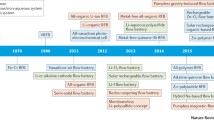Abstract
The Br2/H2 redox flow cell shows promise as a high-power, low-cost energy storage device. The effect of various aspects of material selection, processing, and assembly of electrodes on the operation, performance, and efficiency of the system is determined. In particular, (+) electrode thickness, cell compression, hydrogen pressure, and (−) electrode architecture are investigated. Increasing hydrogen pressure and depositing the (−) catalyst layer on the membrane instead of on the carbon paper backing layers have a large positive impact on performance, enabling a limiting current density above 2 A cm−2 and a peak power density of 1.4 W cm−2. Maximum energy efficiency of 79 % is achieved. In addition, the root cause of limiting-current behavior in this system is elucidated, where it is found that Br− reversibly adsorbs at the Pt (−) electrode for potentials exceeding a critical value, and the extent of Br− coverage is potential-dependent. This phenomenon limits maximum cell current density and must be addressed in system modeling and design. These findings are expected to lower system cost and enable higher efficiency.












Similar content being viewed by others
References
Cho KT, Albertus P, Battaglia V, Kojic A, Srinivasan V, Weber AZ (2013) Energy Technol 1:596–608
Fischer J, Bingle J (1955) J Am Chem Soc 77:6511–6512
Cho KT, Tucker MC, Ding M, Ridgway P, Battaglia VS, Srinivasan V, Weber AZ (2014) ChemPlusChem. doi:10.1002/cplu.201402043
Goor-Dar M, Travitsky N, Peled E (2012) J Power Sources 197:111–115
Livshits V, Ulus A, Peled E (2006) Electrochem Commun 8:1358–1362
Nguyen TV, Kreutzer H, Yarlagadda V, McFarland E, Singh N (2013) ECS Trans 53(7):75–81
Zhang L, Shao ZG, Wang X, Yu H, Liu S, Yi B (2013) J Power Sources 242:15–22
Cho KT, Ridgway P, Weber AZ, Haussener S, Battaglia V, Srinivasan V (2012) J Electrochem Soc 159(11):A1806–A1815
Yarlagadda V, Nguyen TV (2013) J Electrochem Soc 160(6):F535–F547
Kreutzer H, Yarlagadda V, Nguyen TV (2012) J Electrochem Soc 159(7):F331–F337
Park JW, Wycisk R, Pintauro PN (2013) ECS Trans 50(2):1217–1231
Yeo RS, Chin DT (1980) J Electrochem Soc 127(3):549–555
Kusoglu A, Cho KT, Prato RA, Weber AZ (2013) Solid State Ionics 252:68–74
Aaron D, Sun CN, Bright M, Papandrew AB, Mench MM, Zawodzinksi TA (2013) ECS Electrochem Lett 2(3):A1–A3
Aaron DS, Liu Q, Tang Z, Grim GM, Papandrew AB, Turhan A, Zawodzinski TA, Mench MM (2012) J Power Sources 206:450–453
Bai Y (2013) Membrane and performance study in polymer electrolyte membrane fuel cells and hydrogen bromine redox flow batteries. Dissertation, University of Tennessee, Knoxville
Kreutzer HM (2012) Characterization of the hydrogen-bromine flow battery for electrical energy storage. Dissertation, University of Kansas, Lawrence
Xu J, Scherson D (2013) Anal Chem 85:2795–2801
Breiter MW (1963) Electrochim Acta 8:925–935
Bagotzky VS, Vassilyev YB, Weber J, Pirtskhalava JN (1970) J Electroanal Chem 27:31–46
Barna GG, Frank SN, Teherani TH, Weedon LD (1984) J Electrochem Soc 131:1973–1980
Onishi LM, Prausnitz JM, Newman J (2007) Phys Chem B 111:10166–10173
Acknowledgments
The authors acknowledge helpful discussion with Venkat Srinivasan and Vincent Battaglia. This work was funded by Advanced Research Projects Agency-Energy (ARPA-E) of the U.S. Department of Energy (contract nos. DE-AC02-05CH11231 for LBNL and DE-AR0000262 for TVN Systems, Inc.) with cost share provided by TVN Systems, Inc.
Author information
Authors and Affiliations
Corresponding author
Rights and permissions
About this article
Cite this article
Tucker, M.C., Cho, K.T., Weber, A.Z. et al. Optimization of electrode characteristics for the Br2/H2 redox flow cell. J Appl Electrochem 45, 11–19 (2015). https://doi.org/10.1007/s10800-014-0772-1
Received:
Accepted:
Published:
Issue Date:
DOI: https://doi.org/10.1007/s10800-014-0772-1




